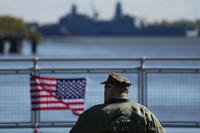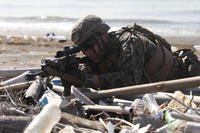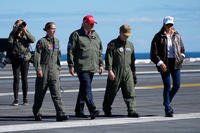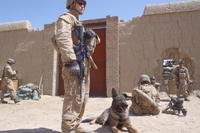U.S. and Iraqi forces have had increasing success in bringing down the small quadcopter drones ISIS uses for reconnaissance and attacks in the fight to retake Mosul, a U.S. commander said Wednesday.
The Iraqi Security Forces (ISF) have also seen a significant reduction in recent weeks in the use of ISIS' primary weapon -- the car bomb or Vehicle-Borne Improvised Explosive Device -- as the Iraqis continue to make gains on the eastern side of the Tigris River that splits Mosul, said Army Col. Brett Sylvia, commander of Task Force Strike in Combined Joint Task Force-Operation Inherent Resolve.
Task Force Strike has been providing precision fire to the ISF with "triple seven" towed M777 155mm howitzers, tracked Paladin M109A6 155mm cannon and M142 High Mobility Artillery Rocket Systems (HIMARS) while also providing ground advisers to the ISF to coordinate airstrikes, Sylvia said.
He stressed that the task force advisers working with the Iraqis are moving with Iraqi brigadier generals. "None of us are on the front lines kicking down doors or shooting people," he said.
The ISF is also increasingly taking over artillery missions from the U.S., Sylvia said. Previously, the Iraqis relied almost exclusively on the U.S. for indirect fire because "they didn't have any trust or confidence in their artillery forces," he said. "Now, as we are in Mosul, there is a whole range of kinetic strikes which can be brought -- some of which are Iraqi, some of which is coalition."
ISIS Drones
In a televideo briefing from Baghdad to the Pentagon, Sylvia said that the Islamic State of Iraq and Syria had earlier used winged drones -- the military prefers the term unmanned aerial systems -- but is now relying mostly on small quadcopters, which they have been able to rig to drop small munitions with the approximate explosive power of a small hand grenade.
The U.S. is using technical means Sylvia declined to describe to bring down the drones, while the Iraqis are relying on direct fire with small arms. Sylvia said about a dozen of the ISIS drones have been brought down or shot down recently, but the munitions they've managed to drop have caused casualties in the ISF.
He said the drones had caused no casualties among U.S. troops. He had no figures on the number of casualties caused by drones to the ISF or on the overall attrition rate for the ISF in nearly 90 days of the offensive to retake Mosul.
Reports from the field also suggest that ISIS is using the drones as a diversion against Iraqi forces. In street fighting in Mosul's eastern sector on Wednesday, Iraqi troops repeatedly turned away from the enemy on the ground to fire machine guns at a cluster of drones circling overhead, Reuters reported.
The use of drones by ISIS is "a capability they've had for pretty much for the duration of the time we've been here," Sylvia said. The difference in Mosul is that "they are actually putting munitions on them and dropping munitions on the ISF."
"We don't talk about ISF casualties," he said, but "I can tell you that [the drones] have resulted in damage to some equipment, damage to some structures and some civilian casualties. They've made them much more effective than they were in the beginning."
VBIED Attacks
ISIS is still relying on VBIEDs as its main strike weapon, Sylvia said, but the frequency and effectiveness of the attacks have declined dramatically in recent weeks. He said about half of the VBIED attacks had been effective in terms of causing casualties or destroying ISF defenses, but the effectiveness rate has been reduced to about one in six attacks.
The VBIEDS used by ISIS also had previously been up-armored in what Sylvia called a "Mad Max" style with only a small eye slit for the driver. "We don't see those anymore," he said.
ISIS is now using stripped-down cars that are harder to distinguish from civilian vehicles, he said.
The ISF has also become more skilled in using shoulder-fired anti-tank weapons to take out the VBIEDs and in using simple defensive measures, such as spreading spikes across a road or cratering roads to prevent attacks, Sylvia said.
In his overall assessment of the siege of Mosul, Sylvia said recent gains are attributable to the new tactics employed by the ISF in what has been called "Phase Two" of the operation that began Dec. 29.
The ISF has shown the capability to attack on different fronts, relieving the pressure on the elite Counter Terror Services units that had been the main strike force, Sylvia said.
Regular ISF units and the Iraqi federal police are now moving on separate fronts in the eastern sector. "It's not like it was back nine months ago, when they struggled to get true combined arms maneuver," Sylvia said.
-- Richard Sisk can be reached at Richard.Sisk@Military.com.































